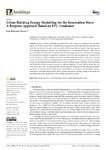Urban Building Energy Modelling for the Renovation Wave: A Bespoke Approach Based on EPC Databases

Use este enlace para citar
http://hdl.handle.net/2183/37365Coleccións
- Investigacion (ETSAC) [511]
Metadatos
Mostrar o rexistro completo do ítemTítulo
Urban Building Energy Modelling for the Renovation Wave: A Bespoke Approach Based on EPC DatabasesAutor(es)
Data
2023-06-27Cita bibliográfica
Rodríguez-Álvarez, Jorge. 2023. "Urban Building Energy Modelling for the Renovation Wave: A Bespoke Approach Based on EPC Databases" Buildings 13, no. 7: 1636. https://doi.org/10.3390/buildings13071636
Resumo
[Abstract] In 2020, domestic buildings represented 27% of the energy consumption in the European Union. The EC Renovation Wave concluded that the annual renovation rate should be doubled, from 1% to 2%, over the next decade in order to meet the 2030 energy efficiency targets. Funding programs are being implemented at national and European levels to accelerate this process. These aim to prioritize large-scale interventions and the most efficient energy conservation measures by including strict performance targets as eligibility conditions. However, these programs are coordinated by local authorities, and they struggle to generate reliable energy estimates for large areas, not least predict potential savings at both aggregated and individual levels. This paper presents a bespoke energy retrofit analysis methodology based on urban building energy modelling, which is defined and calibrated with the Energy Performance Certificate Database. We apply this method to the case study Barrio das Flores. The model adopts a hybrid approach, defining and simulating representative typologies to extrapolate the results to the whole district according to each dwelling’s specific parameters. This methodology will be used to predict the potential energy savings in the study area and support the grant application for the funding renovation program.
Palabras chave
Energy efficiency
Urban building energy models
Building renovation
Urban building energy models
Building renovation
Versión do editor
Dereitos
Atribución 3.0 España © 2023 by the author. Licensee MDPI, Basel, Switzerland. This article is an open access article distributed under the terms and conditions of the Creative Commons Attribution (CC BY) license (https://creativecommons.org/licenses/by/4.0/).
ISSN
2075-5309






